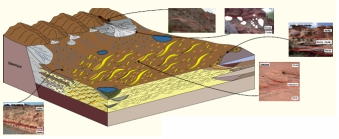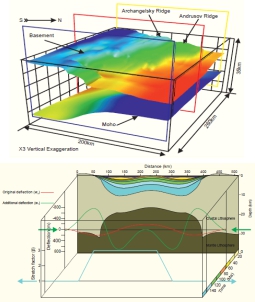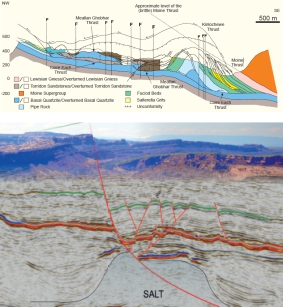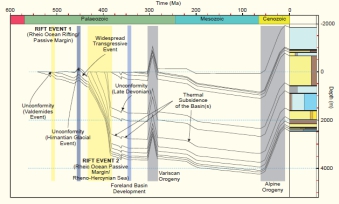Research themes
Members of the Basin Dynamics Research Group undertake pure and applied collaborative research that brings together many aspects of 3D basin modelling. The Group's principal research theme is hydrocarbon exploration, and emphasis is placed strongly upon the use of fieldwork to constrain and develop basin-modelling techniques. This page gives a brief overview of current research directions.
Group collaborators


Sedimentary Evolution of Arid Continental Basins
An understanding of the sedimentological evolution of basins is critical to the evaluation of fluid flow through them. Sedimentological interactions between coeval environments in arid continental basins are studied to investigate the dependencies of environments upon each other, the interacting geometries, and their effects on fluid migration within the subsurface.
The techniques of sequence stratigraphy are applied to arid continental basins in order to explore and understand the evolution of these systems in response to climate change. Past studies have explored the development of environments of the distal basin in response to climatic cyclicity. Current work extends the application of sequence stratigraphical principles to more proximal environments in order to understand the influence of both short and long term climatic variation on the permeability of alluvial fans, and the evolution of ephemeral fluvial systems within aeolian environments. Members of the group study well exposed environments from the intracratonic basins of the Western USA, the Eden Valley of the UK and the Barmer Basin of India as analogues for hydrocarbon provinces of the North Sea and aquifer / contaminant pathways of northern England.
For more information contact: Dr Stu Clarke

Geodynamic Basin Evolution
Two- and three-dimensional numerical models of lithosphere-scale deformation can be utilised to model basin geometry, stratigraphy, and underlying crustal structure following major extensional or compressional events. The modelling can be used to investigate the effects of sequential tectonic events to show structure and stratigraphy caused by multiple rifting or basin inversion.
This modelling approach has been applied successfully to provide insights into the origins and evolution of the northern North Sea, the Larmide province of the western USA, the Black Sea and Caspian Sea basins, and, more recently, to the evolution of the Rockall Trough of the north-eastern Atlantic Ocean.
For further information contact Dr Stuart Egan

Structural Analysis
A deeper understanding of the geometry and kinematics of complex fault systems, at a range of scales, and in both contractional and extensional regimes, is paramount to the effective evaluation and risking of fluid migration pathways. Small-scale features of these systems, such as low displacement fault geometries and fracture networks, are known to influence fluid migration pathways and can contribute to trap compartmentalisation, but are typically below seismic resolution.
Structural techniques applied to compressional settings allow the analysis and interpretation of thrust propagation within complex and polyphase deformational settings. This, combined with field data, allows thrust development to be interpreted and pre-thrust templates determined to give greater insight into the influence of pre-excising structures on thrust development.
In extensional settings, structural techniques are employed to understand the complex kinematics and geometry of accommodation zones developed in response to salt movement, and the influence of pre-existing structures upon rift basin evolution. Members of the group study outcrop examples from the intracratonic basins of the western USA, the highlands of Scotland, and the continental rift basins of India.
For further information contact: Dr Stu Clarke

Basin Stratigraphy and Burial History
Constraining stratigraphy is an essential aspect of any geological investigation. Geological methods are applied to better understand the order of physical, chemical and biological processes that have occurred within the lithological framework. Comparisons and correlations can then be established.
Utilising modern approaches, software and equipment, the Group has successfully provided stratigraphical and evolutionary information for the Paradox Basin of the western USA, the Rockall Trough, the Cantabrian Arc of northern Spain and, more recently, the Barmer Basin of India.
For more information contact Dr Stuart Egan or Dr Michael Montenari

